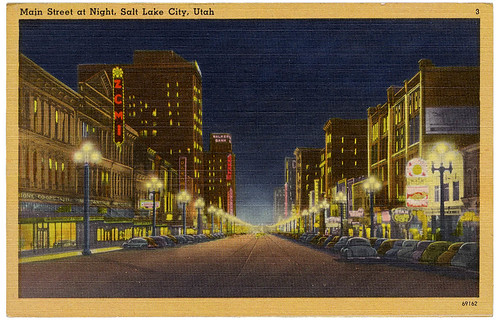Once upon a time there was a restaurant in Berkeley, California called Spenger’s Fish Grotto that had a history dating back to the early part of the 20th century. The food was abundant and good. The waiters were often as crusty as the wonderful sourdough bread that was served.
As a kid and young adult Spenger’s was a regular Friday night adventure. The wait in the bar for a table could take hours. The place was always packed. When I say packed, I mean people out on the street waiting for a chance to even wait inside. And who knows, you might even see someone famous waiting with you.
Click on either image to see it larger.
I never saw the bar as well lit as shown on this card. It was dark and smoky. Okay, I wasn’t fond of the cigarette smoke, but it was all part of the atmosphere. There were several dining rooms, but my favorite is the one shown here on the postcard, the Teak Room. I can remember sitting at one of those center tables watching waiters buzzing through the kitchen doors. The room was always busy. It was my mother’s favorite restaurant.
I bought this menu and napkin several years ago. I don't know exactly what year this menu is from, but it looks exactly like the ones I remember from the 1960s. I like to think that at some point my mother actually held this menu.
Click on any image to see it larger.
It was a family owned restaurant for generations.
My mother's favorite dish was the “Shrimp Scatter” described as “A platter full of Golden Fried Tiny Shrimp. Served with Cole Slaw and French Fries.” Look at the price. $1.85. A whole meal for $1.85. This included lots of crusty sourdough bread which was a classic with their clam chowder.

If you have memories of this place this napkin will look familiar; the only thing missing is the wet ring your glass would have made while you waited and waited for your table.
Sadly, all things change and the Spenger family sold the restaurant to a corporation. For awhile the place was closed. We worried about what changes would be made. I’ve been back once since it reopened. It looked the same outside, the entrance seemed to be similar, and the bar looked as close as my memory would allow. The dining room we were seated in bore no resemblance to the old place. The wait staff was pleasant, but generic. The food…I’ll never go back. What once was a landmark is now nothing more than another restaurant in a corporate chain of over 80 restaurants across the country. Think Red Lobster, but more expensive.
The shining history that may still linger in people’s minds when they hear the name Spenger’s was created by a family dedicated to their customers. There was no website with headings called “Our Investors” or “Our Culture."
As I’ve said before, support family restaurants. Keep the money in your community and not sent off to a corporate headquarters. Cookie cutter food prepared by people towing the company line means that the MBAs are in charge of everything and look how well that turned out for all of us.
 New book NOW available on Amazon.
New book NOW available on Amazon.
















































